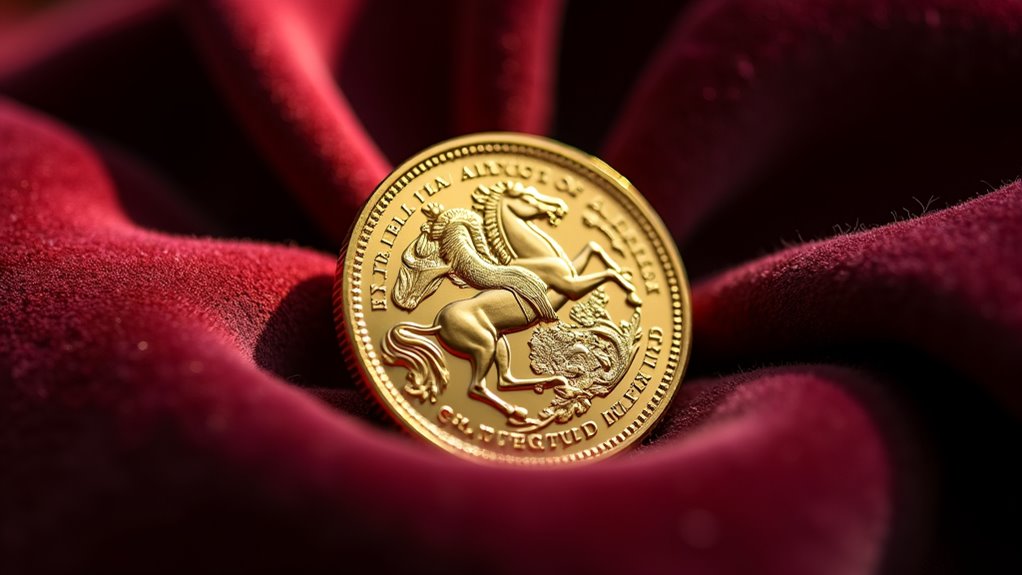Proper storage of gold coins requires maintaining controlled environmental conditions and secure containment. Professional vaults offer round-the-clock security and ideal preservation, while home storage demands fireproof safes bolted securely to foundations. Handling coins with cotton gloves prevents damaging oils and acids, while protective holders shield against humidity and tarnishing. Regular inspections help identify deterioration early. Detailed inventory records support insurance claims and valuations. Discover how these foundational practices safeguard your precious metal investments.

The secure storage and preservation of gold coins represents a fundamental aspect of protecting these valuable investments and collectibles. Professional storage facilities, such as The Royal Mint’s Vault™, provide extensive security measures including round-the-clock surveillance, trained personnel, and complete insurance coverage. These facilities often store coins in serialised, tamper-proof containers and offer convenient buyback programs for investors seeking quick liquidation options. Additionally, many of these facilities adhere to ethical sourcing practices, ensuring that the gold they store is responsibly obtained, which is essential for maintaining consumer trust. To further enhance security, many facilities utilize advanced security systems to protect against theft.
Gold coins require professional-grade security and preservation methods to protect their inherent value as both investments and prized collectibles.
For those preferring home storage, high-quality safes offer a practical solution when properly implemented. These safes should feature both fireproof and waterproof ratings whilst being securely bolted to the ground. It’s essential to maintain appropriate environmental conditions by using desiccants to control humidity and selecting inconspicuous locations to deter potential thieves. Home insurance policies must be updated accordingly to guarantee adequate coverage for stored gold. Additionally, proper storage methods can help prevent deterioration and preserve the coins’ value over time.
Safe deposit boxes at banks present another secure option, though access is limited to banking hours. While these boxes provide excellent physical protection, it’s significant to mention that additional insurance must be purchased separately, as banks don’t typically insure the contents. Protective holders should always be used to safeguard coins from scratches and environmental damage during storage.
Environmental control plays a critical role in preserving gold coins’ condition. Storage areas should maintain consistent temperature control to prevent condensation and tarnishing. Humidity management is essential, making basements and attics unsuitable locations. Protective holders, albums, and silica gel packets contribute to maintaining ideal storage conditions, while direct sunlight exposure should be avoided to prevent discolouration.
Proper handling techniques are fundamental to maintaining coin quality. Cotton gloves should be worn during handling to prevent transfer of oils and acids from hands. Coins should be handled by their edges rather than surfaces, and inspections should occur in clean, well-lit environments. It’s advisable to avoid cleaning agents, as they can potentially damage the coin’s surface quality.
Long-term maintenance requires regular inspection for signs of deterioration or damage. Protective sleeves should be replaced when showing wear, and storage locations should be diversified to reduce risk of catastrophic loss. Professional numismatists can provide valuable guidance for maintaining rare collectible pieces, while maintaining detailed inventory records assists with insurance and valuation purposes.
Alternative storage methods, such as concealment within household items or buried caches, may appeal to some collectors, though these approaches carry their own risks and challenges. Regardless of the chosen storage method, the key principles of environmental control, proper handling, and regular maintenance remain essential for preserving the value and condition of gold coins over time. Cleaning techniques for gold jewelry can also provide insights into maintaining the shine and quality of your coins.
Success in gold coin storage ultimately depends on implementing a thorough strategy that balances security, accessibility, and preservation requirements.
Frequently Asked Questions
How Often Should I Have My Gold Coins Professionally Appraised?
Professional appraisals for gold coins typically depend on market volatility and individual circumstances.
Annual valuations are recommended during periods of significant price fluctuations, while rare or premium coins should be assessed every 3-5 years.
Coins held for investment may need more frequent appraisals to track market trends.
It’s advisable to seek valuations when planning to sell, insure, or update estate plans, or after notable market changes affect similar pieces.
Can I Store Gold Coins With Other Precious Metals?
While gold coins can technically be stored with other precious metals, it’s not recommended due to potential chemical reactions.
Silver, in particular, can tarnish and affect nearby metals.
Best practise is to store gold coins separately in airtight containers made from inert materials.
If combined storage is unavoidable, use anti-tarnish strips and individual protective sleeves to prevent direct contact.
Maintaining low humidity and stable temperatures is also essential for preserving multiple metals together.
What Insurance Options Are Available for My Gold Coin Collection?
Gold coin collectors have two main insurance pathways: standard homeowners insurance and specialised collectibles coverage.
While homeowners policies offer basic protection with typical limits around $2,000 per piece, dedicated collectibles insurance provides extensive coverage specifically designed for valuable collections.
For collections worth $50,000 or more, specialised insurance is recommended, offering agreed-value coverage, worldwide protection, and expertise in accurate coin valuation without affecting home insurance premiums.
Should I Keep Documentation of My Gold Coin Purchases?
Keeping thorough documentation for gold coin purchases is absolutely crucial.
Proper records serve as proof of ownership, verify authenticity, and facilitate future resale opportunities. Documentation should include purchase invoices, certificates of authenticity, and hallmarking details.
These records protect against fraud, simplify insurance claims, and guarantee compliance with tax regulations. They also establish a clear ownership history and help maintain the coins’ value in the secondary market.
How Can I Verify the Authenticity of Gold Coins Before Storage?
Verifying gold coin authenticity requires a multi-faceted approach.
Physical inspection under magnification helps identify irregularities, while precise measurements confirm correct dimensions and weight.
Non-destructive tests like magnetism checks and electrical conductivity assessments can reveal counterfeits.
For absolute certainty, professional verification through XRF analysis or trusted third-party grading services like PCGS offers thorough authentication.
A combination of these methods guarantees the highest confidence in coin legitimacy.













